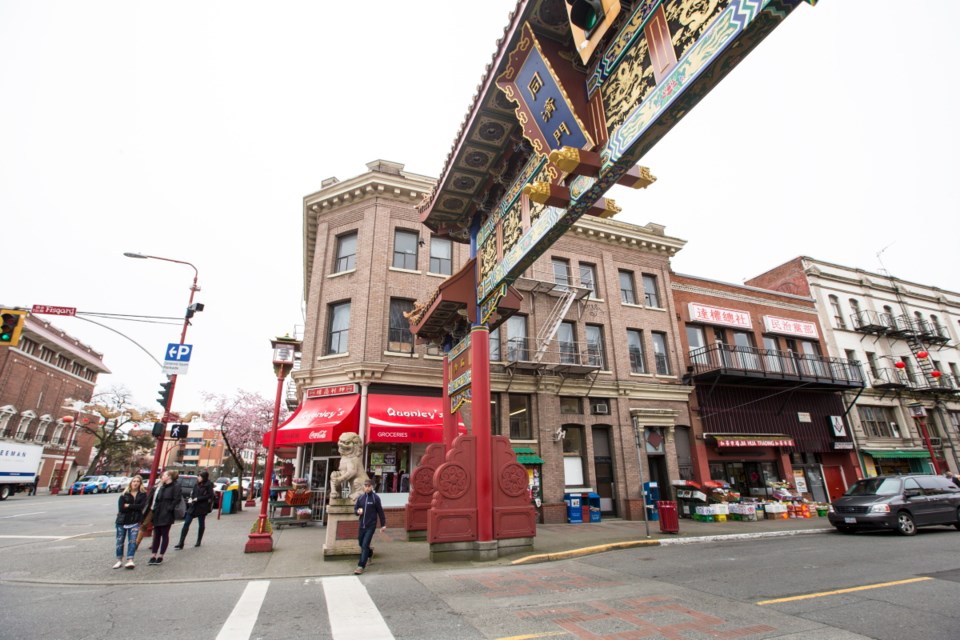 Everybody — or at least everyone who has taken visitors downtown — knows the Chinatown Fan Tan Trading Company.
Everybody — or at least everyone who has taken visitors downtown — knows the Chinatown Fan Tan Trading Company.
It’s one of a kind in Victoria, a store of brightly coloured, cramped chaos. A riot of merchandise — soaps, tea whisks, Chinese finger traps, wicker baskets, vintage Asian porcelain — clings to the banks of a narrow retail river that meanders from Fisgard Street to Fan Tan Alley.
Except now, the river is being dammed. By May, the back end of the shop will be taken over by a furniture dealer. The existing emporium is shrinking.
That’s symbolic of what’s happening in the neighbourhood as a whole: It’s vibrant, but not as Chinese as it once was.
The visibly Chinese presence in Canada’s oldest intact Chinatown is a little less visible, limited largely to the top half of Fisgard between Government and Store streets, with a few shops spreading down Government and up toward Douglas. Nibbling at the edges and sprinkled in between are homes and businesses that, as hip and attractive as they might be, tilt more toward Bohemia than Beijing. Fan Tan Alley owes less to 1880s Chinatown than 1970s Gastown.
The question is: What do people want Chinatown to be? A slice of the 19th century, preserved in amber? Tourism magnet? Cultural incubator? And how much does the area rely on the Chinatown cachet?
The neighbourhood is thriving overall. Developers, property owners and the city have done a terrific job of rejuvenating a part of town that many forget was crumbling a generation or so ago.
The city has a great program that offers property-tax breaks when seismic upgrades are included in the renovation of heritage buildings.
That has helped breathe life into downtown while preserving the history and character of the buildings of Chinatown, which Ottawa designated a national historic site in 1995.
“That incentive keeps buildings intact,” says Victoria city Coun. Charlayne Thornton-Joe.
The thing is, the occupants of those spruced-up buildings tend not to be Chinese.
“Part of me is happy that there is no vacancy,” Thornton-Joe says. “There are no empty storefronts in Chinatown.”
But part of her worries that what made the Chinatown community of her childhood so special could slip away.
It’s not an either/or proposition. The issue isn’t really encroachment by non-Chinese influences, but the sustainability of Chinatown itself. It seems Chinatown is like farmland: Everyone treasures it, everyone wants it preserved — but few want to be a farmer.
Like farming, running a traditional Chinatown business can be a grind. Parents such as Thornton-Joe’s worked seven days a week, 10 to 12 hours a day, so that their kids wouldn’t be chained to restaurant and grocery jobs with no benefits.
“They wanted us to get university degrees and move onto jobs that they thought gave us opportunities for a better future.” That’s what happened, and the nature of the place shifted, in consequence.
This change is not new. In 2009, the Times Colonist’s Ann Hui caused a kerfuffle when she wrote that Chinatown was not so much a place where people of Chinese background could lead their daily lives as it was “an exercise in ethnic amusement” for tourists.
Residents fired back that Victoria’s Chinatown had more authenticity, a more dynamic community, than Hui described.
That remains true today. People of Chinese heritage still live there. A couple of herbalists remain. So do the school and Buddhist temple. The Loy Sing butcher shop, where barbecued pork hangs enticingly in the window, might be the longest continually operating business of any Chinatown in North America. The Chinese associations still have their halls in the neighbourhood. “There are still people playing mah-jong upstairs on certain days,” Thornton-Joe says.
But the Fan Tan Alley barbershop where the old men gathered is gone. The kung fu club, the one that stages the lion dances, recently moved. Victorians no longer have to go to Chinatown for a Chinese meal; the delicacies once only available on Fisgard Street can now be found in the Asian section of your local grocery store.
Some aging Chinatown business owners are having trouble finding buyers for their businesses.
As for the Chinatown Fan Tan Trading Company, it is seeing a steady stream of nostalgic customers as word of its contraction spreads. People who meandered through as children are bringing their own children now. Kids want to walk through the door that Jasmine walked through in Julie Lawson’s children’s book White Jade Tiger.
There’s no word on what will happen to the mini-museum display of Chinatown artifacts. It was assembled by the man who opened the store in 1979, Bill Harris — a non-Chinese man who was fascinated by the culture.
The shop’s costumed mannequins — one chopping wood, the other working behind the desk of a gambling house — will be removed from their alcoves and dismantled.
As for Chinatown overall, those who want to sustain it can always vote with their wallets, spending in those places they want to remain.



